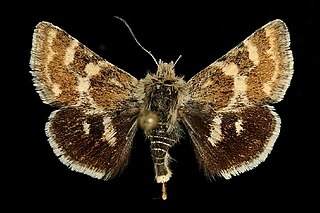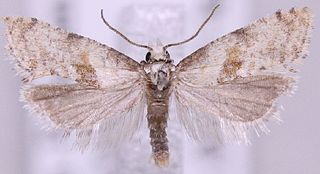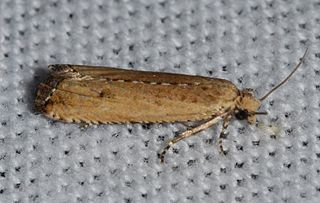
The Tortricidae are a family of moths, commonly known as tortrix moths or leafroller moths, in the order Lepidoptera. This large family has over 11,000 species described, and is the sole member of the superfamily Tortricoidea, although the genus Heliocosma is sometimes placed within this superfamily. Many of these are economically important pests. Olethreutidae is a junior synonym. The typical resting posture is with the wings folded back, producing a rather rounded profile.

The Archipini are a tribe of tortrix moths. Since many genera of these are not yet assigned to tribes, the genus list presented here is provisional.

Lobesia botrana, the European grapevine moth or European grape worm, is a moth of the family Tortricidae.

Schinia intermontana is a moth of the family Noctuidae. It is found from British Columbia south to Montana, Washington and Colorado.
Licigena is a monotypic genus of moths belonging to the subfamily Olethreutinae of the family Tortricidae. Its sole species is Licigena sertula, which has been found in Sri Lanka. Both the genus and species were first described by Alexey Diakonoff in 1982.
Sorensenata is a genus of moths belonging to the subfamily Tortricinae of the family Tortricidae. It contains only one species, Sorensenata agilitata, Sorenson's agile moth, which is found in New Zealand, where it has been recorded from Campbell Island.

Diedra is a genus of moths belonging to the family Tortricidae.

Crocidosema lantana, the lantana flower-cluster moth or lantana tortricid moth, is a moth of the family Tortricidae. It was first described by August Busck in 1910. It is native to Mexico and the southern United States, but was introduced to Hawaii in 1902, Australia in 1914 and the Caroline Islands in 1948 and 1949 to aid in the control of Lantana weeds. It has also been recorded from Yunnan, China and in Sri Lanka.

Lobesia aeolopa is a moth of the family Tortricidae first described by Edward Meyrick in 1907. It is found in Vietnam, Thailand, India, Sri Lanka, Myanmar, Java, the Solomon Islands, Korea, Japan, Taiwan, São Tomé and Príncipe, Tanzania, South Africa, Réunion and Madagascar.

Homona coffearia, the tea tortrix or camellia tortrix, is a moth of the family Tortricidae. The species was first described by Nietner in 1861. It is widely distributed in the Oriental region.
Phricanthes flexilineana is a species of moth of the family Tortricidae first described by Francis Walker in 1863. The species was described from Sri Lanka, northern Queensland in Australia and the Seychelles, but has a much wider range, which includes Madagascar, India, Indonesia, Myanmar, New Guinea, the Philippines and Taiwan. It is also widely distributed in the tropical parts of North and South America.

Cochylidia heydeniana, the blue-fleabane conch, is a moth of the family Tortricidae. It was described by Gottlieb August Wilhelm Herrich-Schäffer in 1851. It is found from most of Europe to China (Xinjiang), Mongolia, Korea, Russia and Japan. The habitat consists of dry pastures, wasteland and sand dunes.

Cochylidia subroseana, the dingy roseate conch, is a moth of the family Tortricidae. It was described by Adrian Hardy Haworth in 1811. It is found from most of Europe to China, Russia, Korea and Japan. It has also been recorded from North America.

Aethes sanguinana is a species of moth of the family Tortricidae. It was described by Treitschke in 1830. It is found in most of southern and central Europe, Morocco, Algeria and Asia Minor.

Cochylichroa hoffmanana, or Hoffman's cochlid moth, is a species of moth of the family Tortricidae. It was described by William D. Kearfott in 1907. It is found in France and North America, where it has been recorded from California, Connecticut, Florida, Illinois, Indiana, Kentucky, Maine, Manitoba, Maryland, Minnesota, New Brunswick, New York, Newfoundland, North Carolina, Nova Scotia, Ohio, Oklahoma, Ontario, Quebec, Tennessee and Vermont.
Diedra calocedrana is a species of moth of the family Tortricidae. It is found in the United States, where it has been recorded from California.
Diedra leuschneri is a species of moth of the family Tortricidae. It is found in the United States, where it has been recorded from California.

Diedra cockerellana, Cockerell's moth, is a species of moth of the family Tortricidae. It is found in North America, where it has been recorded from California, Colorado, Illinois, Indiana, Iowa, New Mexico, Ontario, Utah and Wisconsin.
Diedra wielgusi is a species of moth of the family Tortricidae. It is found in North America, where it has been recorded from Arizona, Nevada, New Mexico, Ontario and Texas.

Bactra verutana, the javelin moth, is a species of moth of the family Tortricidae. It is found in North America, where it has been recorded from Florida, Texas, Mississippi, North Carolina, Indiana, Missouri, Ontario, Alberta, Quebec and Labrador. It is also found in Cuba, Mexico, Panama, Paraguay, Puerto Rico, Mozambique and South Africa. The habitat consists of prairies, aspen parkland, foothills and mixed wood areas.












